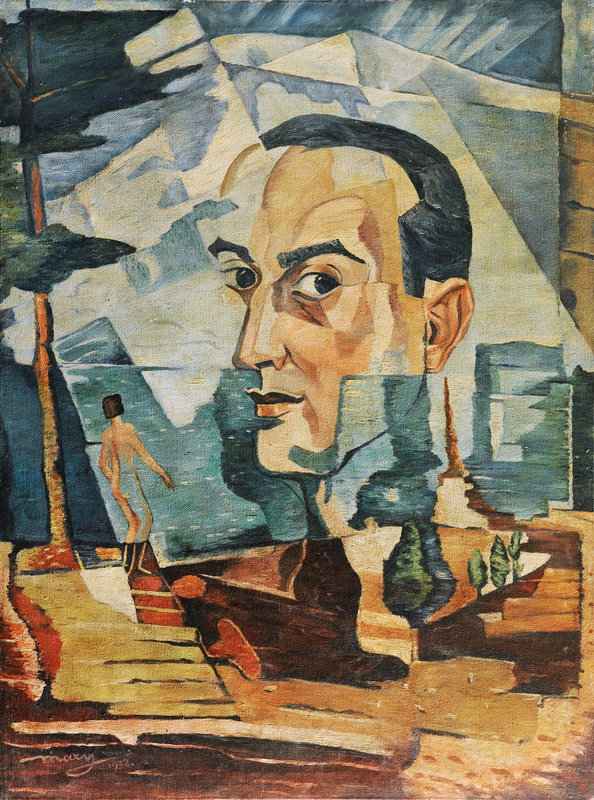
For more than a century, the visual arts have been a reflection of the dual identity of the Romanian Jews; interaction as well as the confrontation between the Jewish and Romanian cultures; this chapter allows you a glimpse into this area.
The modern identity of Romanian Jews developed simultaneously with the Romanian identity. Jewish artists in Romania, like other artists, were influenced by modern trends in European art, in the spirit of the Academic art, Romanticism and patriotism, and wanted to express their political and social values in their works.
The struggle for emancipation of the Jews in Romania began during the 1848 Revolution, and two of the three artists that were engaged in the preparation of the symbols of the revolution. Barbu Iscovescu, who created the tri-colored flag with its slogans, "Justice-Brotherhood" and Constantin Daniel Rosenthal who painted "Revolutionary Romania" and "Romania Breaking off her chains ", along with Ion Negulici were called "The Painters of the Revolution."
At the beginning of the 20th century the majority of avant-garde artists from Romania, and the most important among them were of Jewish origin. The explanation for this probably lies in the complex relations between Jewish artists and Romanian nationalism, which advocated one state for one nation. The anti-Semitic professor Alexandru Cuza applied these ideas to artistic work. In his book, 'Nationalism in Art', published in 1908, Cuza defined a nation as a being of a homogenous ethnic entity, and argued that art, the supreme expression of culture, must be intrinsically related to nationality, and therefore foreigners cannot express the true nature of Romanian culture. The foreigners that Cuza is referring to were first and foremost Jews, who, in his opinion, were "definitely an inferior ethnic group" of a different race, culture, and incapable of assimilation. For Cuza the idea that "beauty has no homeland" was heresy.
Cuza 's statement that true Romanian art is national art and therefore only Romanian nationals can be Romanian artists, was adopted at the time by most Romanian intellectuals. It is clear that under these circumstances it was difficult for Jewish artists, who, like all Romanian Jews until 1919, were considered foreigners, to identify fully with a cultural atmosphere which rejected them, whereas the universalism of the avant-garde attracted them. Max Herman Maxy put it clearly in an editorial in the avant-garde journal 'Integral ' published from 1925-1928: "We strongly reject the false tradition of the soil and bow to the endless tradition of man. The first is conservatism, the second is civilization." Thus, among the avant-garde artists in Romania, Jews were the majority. The most prominent among them were Marcel Iancu, Arthur Segal, Max Herman Maxy, and Victor Brauner.
Jewish artists in Romania were active in various avant-garde movements, and only occasionally did their works deal with issues related to Jewish tradition and culture, including Nicolae Vermont, Iosif Iser, Margareta Streian and Arthur Segal.
The late 1930's were difficult years for the Romanian Jews, and artists were not immune from violent attacks on ethnic grounds. A cartoon of the artist Max Herman Maxy in the fascist Romanian newspaper Porunca vremii (Order of the Hour) portrayed him as a "Jew," who paints with "kosher ink" and "poisoned" the art with the venomous snake he uses as a brush. During these years many artists left Romania; Victor Brauner and Jules Perahim moved to Paris and Iancu to Palestine.
Jewish photographers in Romania, such as Iosif Berman, focused on portraits, personalities and social issues. They took advantage of the possibilities of photography to document various classes and Jewish society in Romania; the wealthy bourgeoisie as well as the Jewish peasants during the first half of the 20th century.
As far as Romanian art is concerned, it is important to mention the contribution of the Jewish collectors who provided for the flourishing of art created by both Romanian and Jewish artists. Due to collectors such as Astride Blank, Elie Bercovici,Weinberg, Grunber-Ruleta, Ionel Ilianu, Aurel and Varinca Diaconu, Romania's museums and many private collections shelter masterpieces of Romanian art.
Amelia Pavel, "Jewish Painters in Romania, 1848-1948", Editura Hasefer, Bucharest 2003